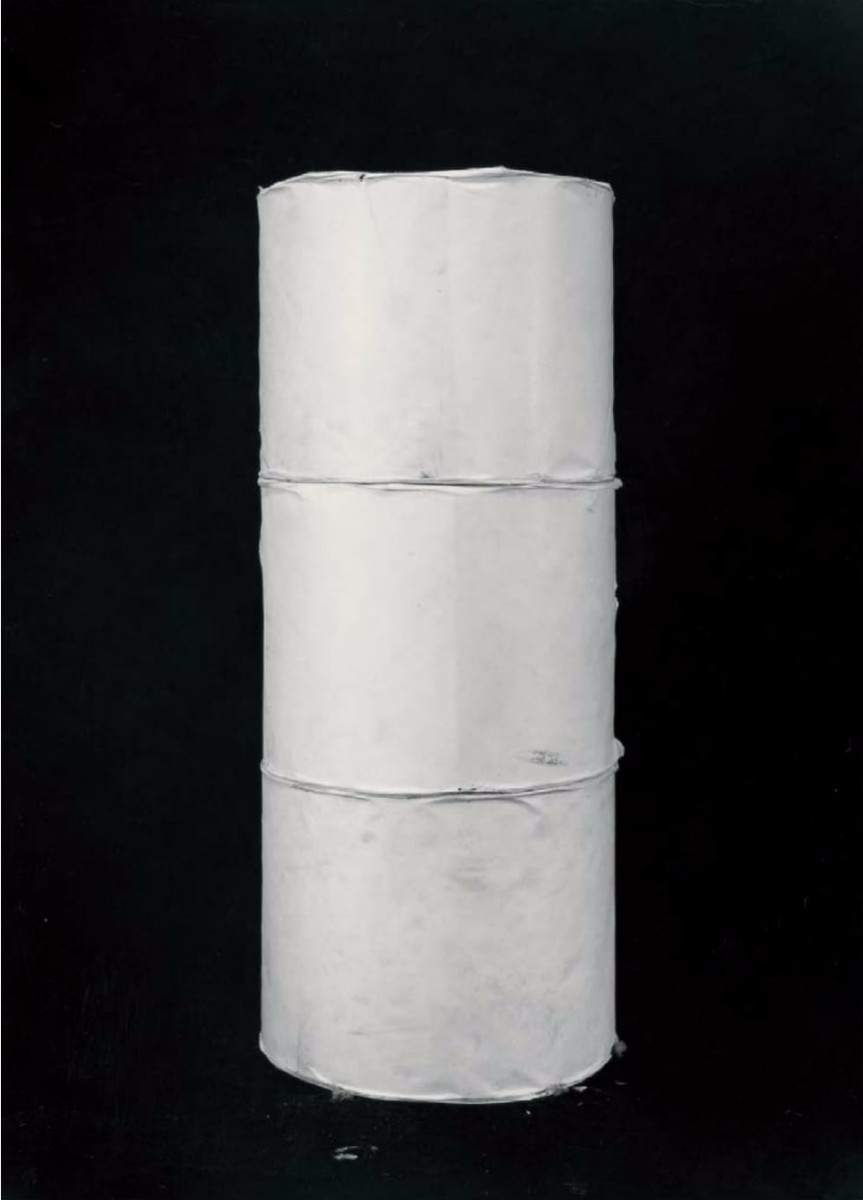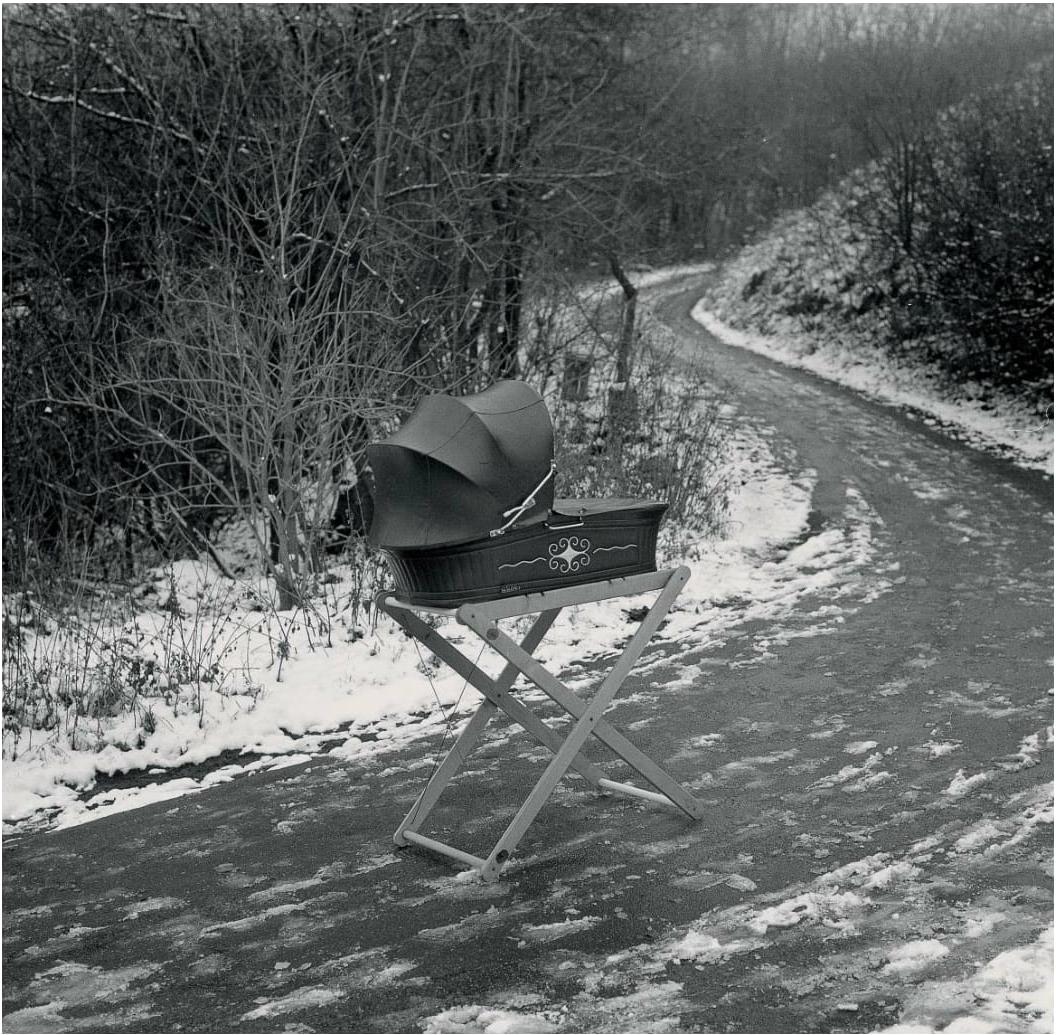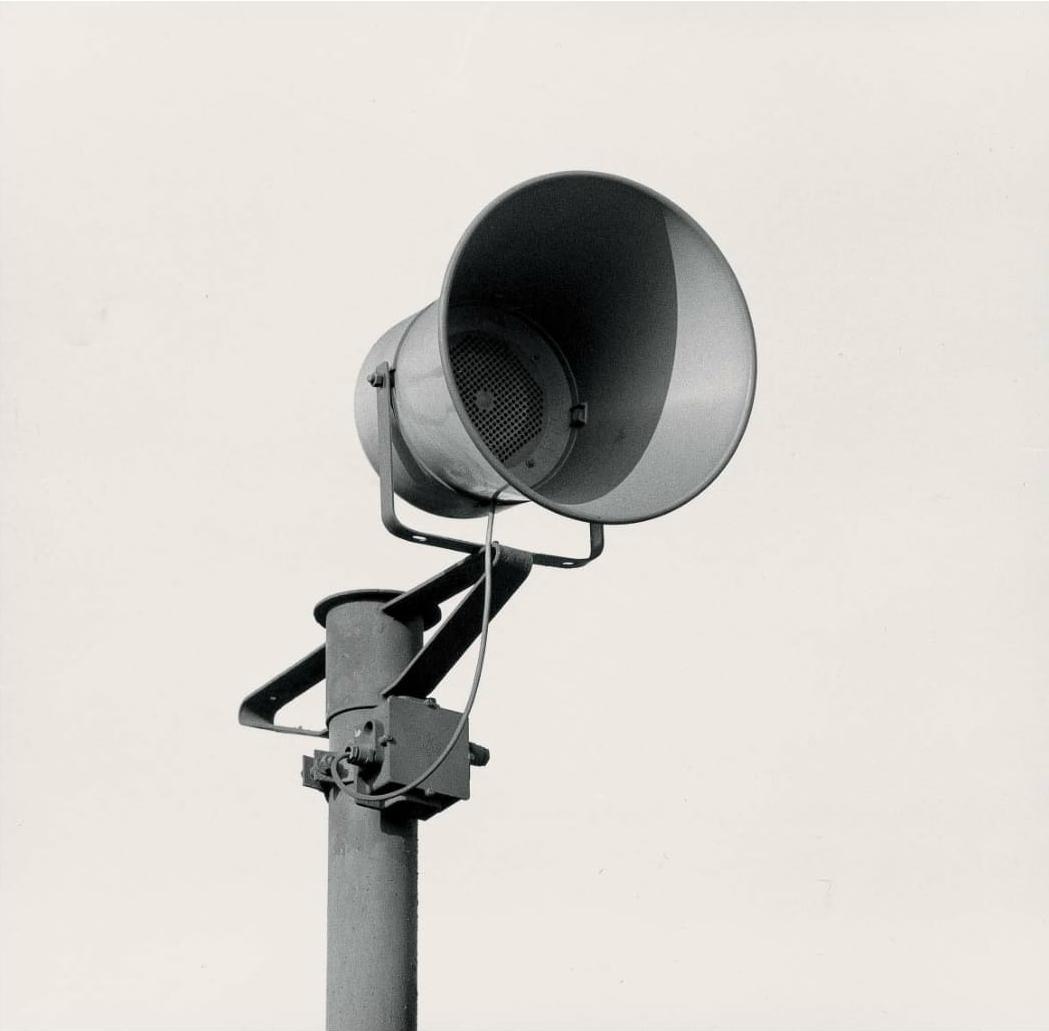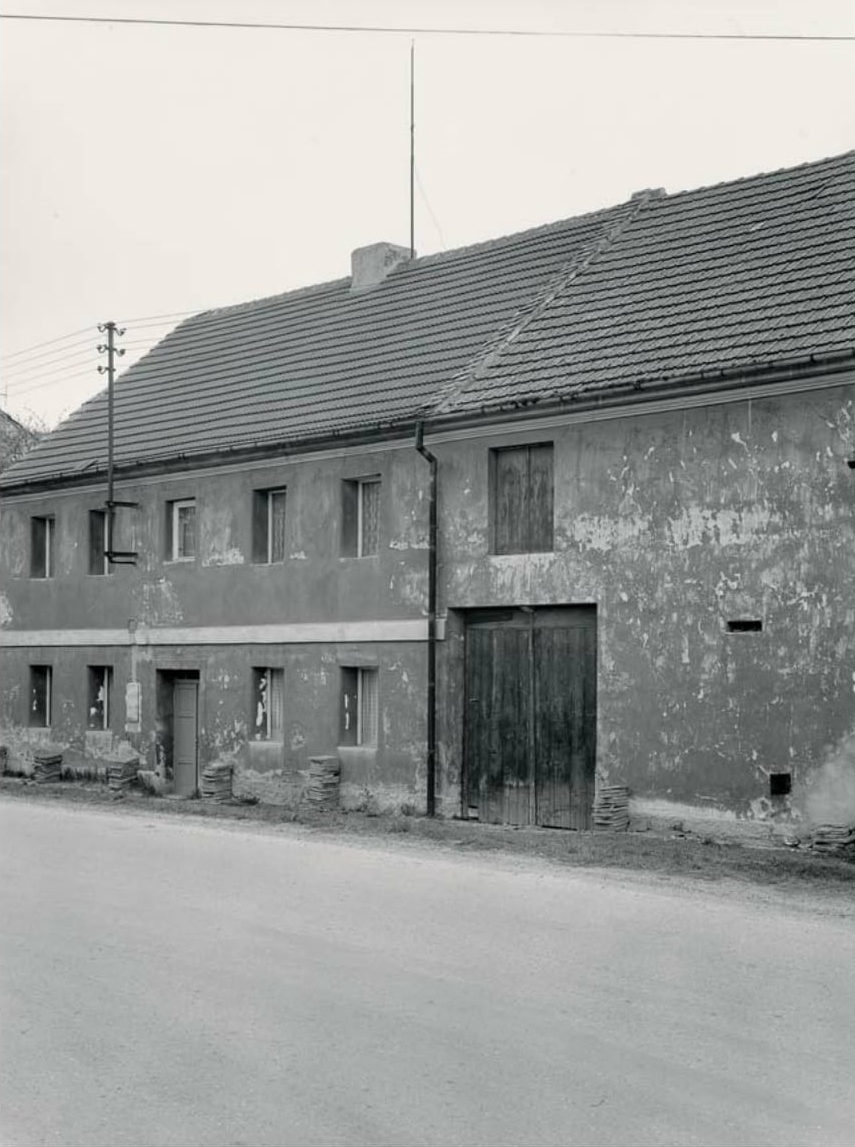Jasanský & Polák
absolut equivocation
‘A photograph is an absolute singularity, a consummate contingency, rigid and dull, it is that which it is.’
/Roland Barthes/, Camera Lucida
The results of the collaboration dating back to 1986 between Lukáš Jasanský and Martin Polák are in almost perfect harmony with the principle governing the medium they use: they are obvious at first glance and yet often contain a quite subversive and even conspiratorial subtext which radically puts in doubt and quiets first reactions to their work. We could say that the basic principle behind their work is a tension between their subject matter and the way they present it. Although their work in classic photography is flawless from a technical point of view and the demanding large formats they use along with the black-and-white film are typical of ‘art photography,’ the main source of the tension in their work is the striking contrast created by the illogic, ambiguity and banality of what they photograph. In this way, they make transparent a certain innocence inherent in photography which can be threatening and inexpressive –and at the same time seductive and fun.
Although the thematic spectrum of their work spans such classical photographic categories as social journalism, landscapes and still lifes, the principle guiding their photographic series is basically the same. The most interesting moments in their work occur when they comment on images using other images, which might seem facile at first. Nevertheless, the images are never simply juxtaposed, but contrasted, set against one another. It is not necessary to describe them, for the underlying basis of the image would be lost. Instead, they reflect off of one another and bestow new meanings on the universe of images. There is even meaninglessness in the case of Jasanský and Polák: a meaninglessness from the standpoint of a literary description which might call attention to the fact that the images have resorted to their own language –a language that it is not always possible to decipher. In their photographs, we feel like we are on the frontier of photographic meaning –sometimes we even feel we have left the frontier behind— whenever they perform a sort of salto mortale (a death-defying jump) by photographing that which it makes no sense to photograph, in order to give their own picture-taking act meaning. In their own words: ‘Yes, senselessness is our strong point. If we entertain any concept, as one says today, when we begin thinking of a photograph, we immediately try to disguise, scramble, or destroy it. Similarly, we prefer a neutral tone over one that is critical or value-giving, which best expresses our wonder at reality.’ (interview with M. Pachmanová in Labyrint revue 1999; 5-6). It is difficult to present their photographs individually, as well. If we look at a singe, isolated picture, it might make sense by itself. When placed in context, however, the effect is total confusion –not because the photographs do not work well together or relate contrapunctally, but because it is only when they are taken as a whole that they constitute one single photograph, that ideal photograph which makes no sense. Whereas in traditional photographic compositions the general sense derives from the context as a whole, in the case of Jasanský and Polák one comes to the clear conclusion in the end that the whole simply lacks significance.
The work of Jasanský and Polák raises though-provoking questions regarding the manner in which frontiers are laid down in classical photography and contemporary art. Their relationship to photographic tradition is evident in the clearly sardonic names they have given some of their exhibitions: ‘Abstract Photographic Fart,’ ‘Anti-War and Humanitarian Photographs,’ ‘Photography Exhibition, 1990.’ Despite the fact that over ten years of work have established them among the most important young Czech artists today, within the framework of the specialised photographic community they encounter, in the best of circumstances, dismissal and more generally, absolute incomprehension. Which shows that the frontiers of photographic discourse where Jasanský and Polák concentrate their efforts are invisible for those in the mainstream. Apparently, their favourite target is the very photographic community that produced them, without which they would not exist. They are often branded by that community as ‘pseudo-artists’ who have worked one endlessly repeated idea into the ground, thus attempting to exalt vacuity as an authorial principle. Many critics, mostly from the ranks of tradition-bound photographers, are unable to understand that art does not have to be the fateful, meaning-instilled act of the Romantics, but can also be a provocation, an open question or a tentative and entertaining game (or even all of them at once). On the other hand, it should be noted that often the things Jasanský and Polák parody unwittingly really do exist on today’s ‘art photography’ scene. On the opposite end of the imaginary circle (or Möbius strip?) of photographic art we find works whose opposition with respect to the pictures of Jasanský and Polák is evident for the most part within the context in which they are presented. For Jasanský and Polák, contemporary ‘Humanitarian documentary’ photographs are unexpressed and yet ineffably interesting examples of the gradual emptying out of Cartier-Bresson’s theory of decisive moments (as they clearly demonstrated in their exhibition, ‘Anti-War and Humanitarian Photographs’). In a similar fashion, they attempt to make connections in their own way with the heritage represented by sociological photography (the series ‘Kuranda,’ which captures, in an altered quote by August Sander, the typology of Korean automobiles in Czech streets), or photography tending towards lyrical abstraction (‘Abstraction’). It is as if these positions stood against other, on opposite sides of a frontier. While the abovementioned type of photography says: ‘There is something unexplainable here,’ Jasanský and Polák guilefully suggest ‘There is nothing unexplainable here.’
The question of the possible significance of those of their photographs which might be grounded in the social or historical spheres is particularly present in a series they presented in 1998 under the title ‘Pragensia.’ Whereas many are of the opinion that the banal images of the banal outskirts of Prague in the 1980s have a high documentary value based on the mastery they evince, which comes close to perfection, others consider the subject to be a mere reflective surface for a more complicated (or perhaps simpler) intention: to bore (or entertain) the viewer in a wide variety of ways. Looking at their photographs, one might be reminded of the legendary Eugen Atget, in whose ostensibly ordinary photographs the Surrealists found so much extraordinary beauty. Where others have discovered Surrealism in Atget, Jasansk˘ and Polák show, on the contrary, an absence of meaning against a background of historical reality and experience. However, just like Aget, they say: ‘…all we will leave behind are pictures, but they will wonder at them with amusement, to boot.’
Perhaps the clearest proof of their provocative intent is their series ‘Jokes.’ Here, Jasanský and Polák invoke the Dadaist tradition most explicitly, thus enriching their post-conceptual purposes. (Recall that Benjamin wrote of Dadaism as a programmatic destruction of the aura). ‘Jokes’ is exceptional in the context of their work in that the photographs are provided with explanatory texts. However, they explain nothing, of course; instead they evoke a sort of ‘tongue-in-cheekness’ which makes no sense. They are nothing but a parody of any kind of effort at exegesis carried to an absurd extreme by means of hedonistic and sarcastic commentaries on all of the photographic subtitles of the world.
The specific character of the work of Jasanský and Polák is determined to a large extent by the twofoldness of their authorial ego. Their idea of collective authorship has little to do with modern collectivism; their combined identity is not constituted according to a rational schedule or plan, but is rather a noncommital playfulness. Far removed from any sort of collective delivery, the way they present their work is comparable to a secret game in which they are quite absorbed and whose rules only they are privy to. Thus, their work is characterised by a marked esotericism, often as obscure and mysterious as it is satirical and amusing. One could say that Jasanský and Polák have basically invented their own language in which they communicate with each other, leaving others to do their best to try and understand them. Although this might sound schematic, the fundamental motivation and generating force of their work is above all a dialogue; the discovery of the hidden possibilities of that which is meaningful or meaningless in the communication between two disparate personalities. Fortunately for viewers, an approach is opened up, unintentionally, which one could call the driest sense of humour in Czech photography. The photographs of Jasanský and Polák often remind one of pictures out of textbooks for learning foreign languages; they are pictures from far away which speak a different tongue, so to speak. The relationship between them and the public is reminiscent of that between a speaker who knocks out the public with his first gag and then keeps them laughing despite themselves with every new joke. It seems that this conspiratorial moment is key for the photographers; it permits them to move onward. One could say that anyone who understands one of their photographs understands all of them (including those that have not yet been taken); as if their images were a double mirror for photographic meaning, like Alice’s looking-glass gateway to Wonderland, the realm of nonsense, where one wander as long as one wants.
”…v umění jde především o to, vytvářet díla, která konstituují dílo jako takové, a v něm se sama ještě jednou přezkoumávají. K tomu není nutná žádná teorie; dokonce bych chtěl říci, že je nutné nemít žádnou teorii,” writes Jean-Francois Lyotard. Both parts of the quote can be brought to bear on the work of Jasanský and Polák. However, what they themselves say with regard to their intentions is hard to pin down; their only clear intention is based on their efforts to provoke feelings of unwontedness. They let others pronounce themselves on their concrete programme if they like. The project titled ‘Photography Exhibitions,’ presented in February 1999 at the ·pálova Gallery in Prague, displayed documentary photographs relating to previous exhibitions of theirs on the walls of the gallery. These ‘photographs of photographs’ can be considered, within the context of their trajectory, to be both their first backward glance (conceived in their own particular manner) and a step in a new direction in which their conception is all of a sudden much more explicit. On the other hand, it might seem like they were finally admitting that it had all been a joke, that what was at issue was not photography at all; that it was simply a matter of exhibiting something, giving some people a bit to think or even write about, and have a bit of fun in the meantime. Maybe that is why it is impossible to write about them without succumbing to a certain sheepishness for having taken their bait, despite all our efforts. Are Jasanský and Polák the greatest followers of Jan Svoboda, or simply sophomoric scoundrels? Their singularity lies precisely in that they are both at the same time.
#2 collective authorship
Archive
- #45 hypertension
- #44 empathy
- #43 collecting
- #42 food
- #41 postdigital photography
- #40 earthlings
- #39 delight, pain
- #38 death, when you think about it
- #37 uneven ground
- #36 new utopias
- #35 living with humans
- #34 archaeology of euphoria
- #33 investigation
- #32 Non-work
- #31 Body
- #30 Eye In The Sky
- #29 Contemplation
- #28 Cultura / Natura
- #27 Cars
- #26 Documentary Strategies
- #25 Popular Music
- #24 Seeing Is Believing
- #23 Artificial Worlds
- #22 Image and Text
- #21 On Photography
- #20 Public Art
- #19 Film
- #18 80'
- #17 Amateur Photography
- #16 Photography and Painting
- #15 Prague
- #14 Commerce
- #13 Family
- #12 Reconstruction
- #11 Performance
- #10 Eroticon
- #9 Architecture
- #8 Landscape
- #7 New Staged Photography
- #6 The Recycle Image
- #5 Borders Of Documentary
- #4 Intimacy
- #3 Transforming Of Symbol
- #2 Collective Authorship
- #1 Face










